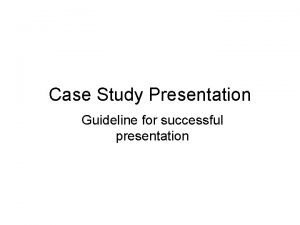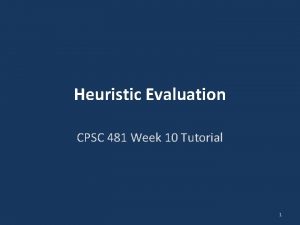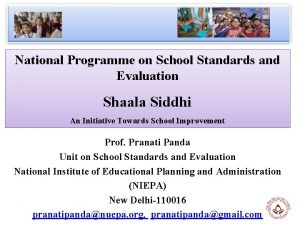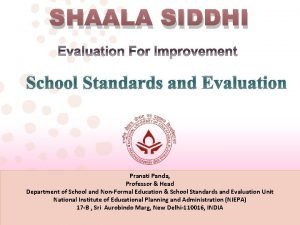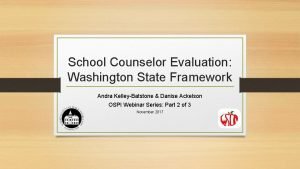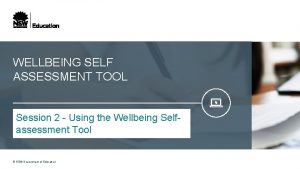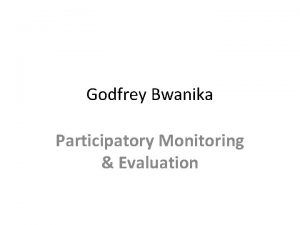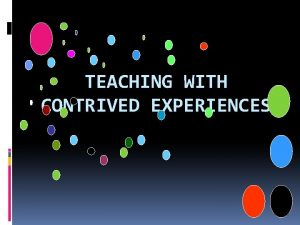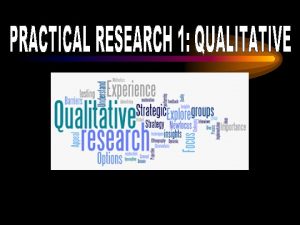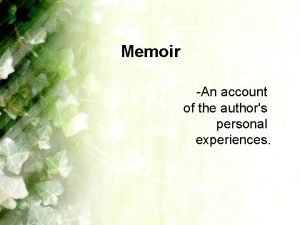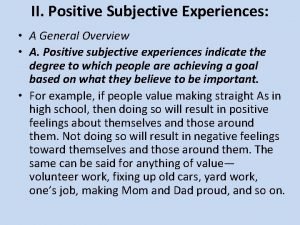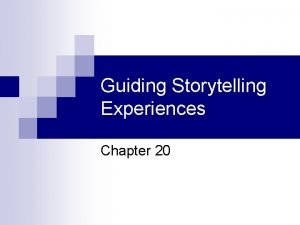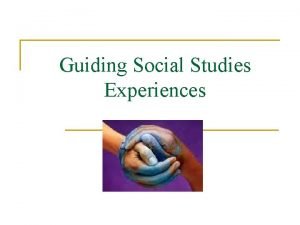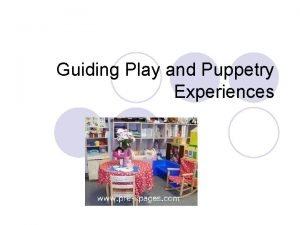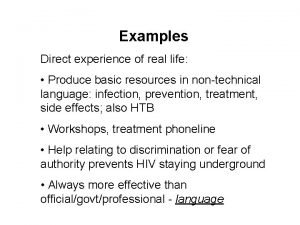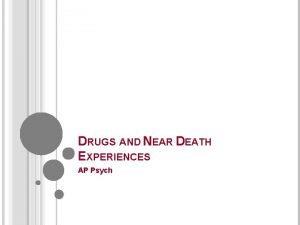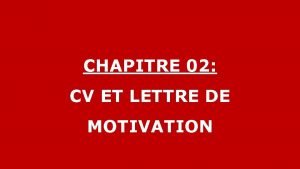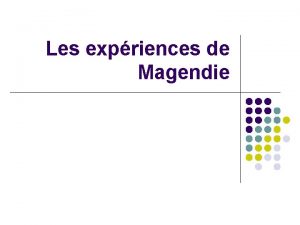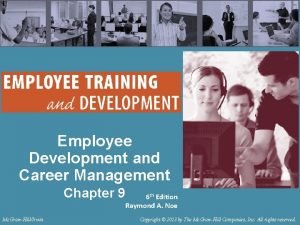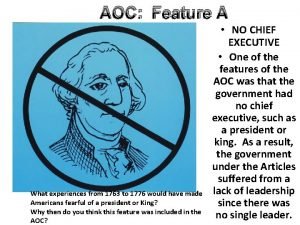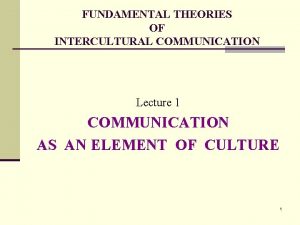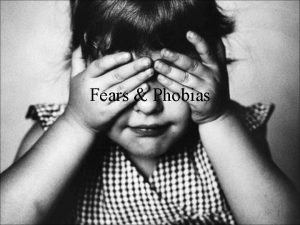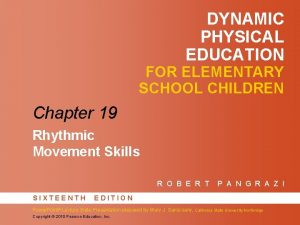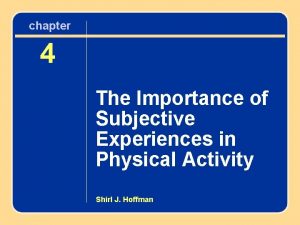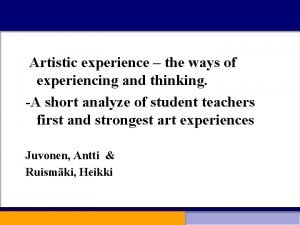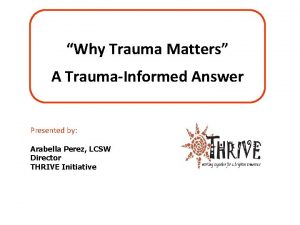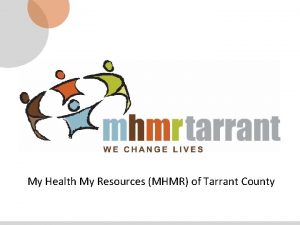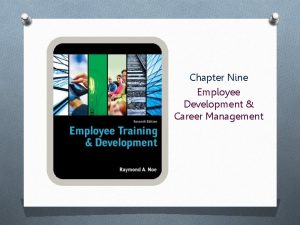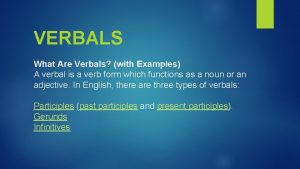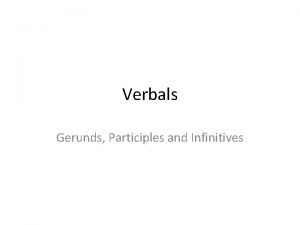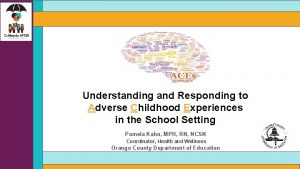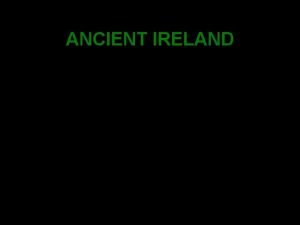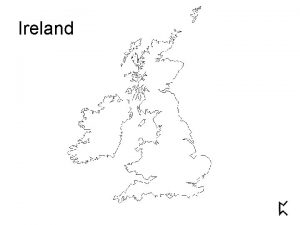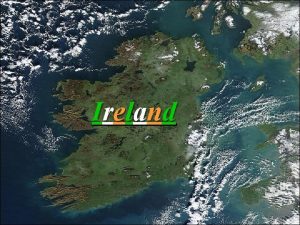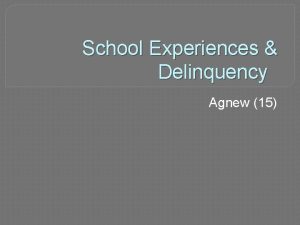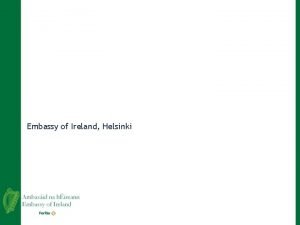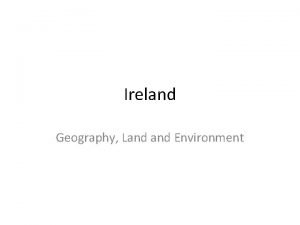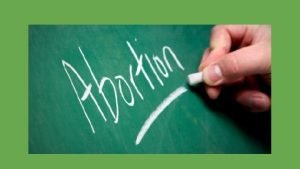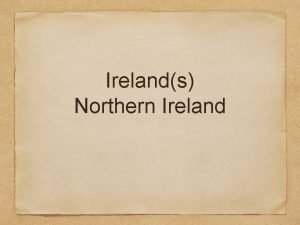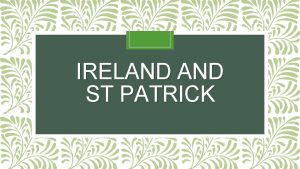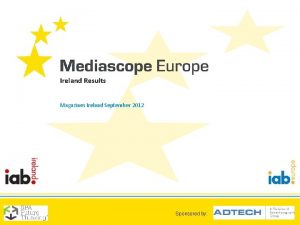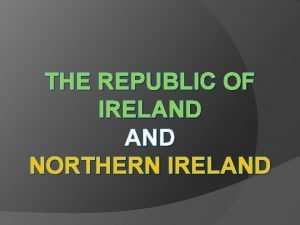Experiences of school evaluation in Ireland a presentation








































- Slides: 40

Experiences of school evaluation in Ireland a presentation to Inspectorate of Education in the Basque Country 5 Pádraig Mac Fhlannchadha, Assistant Chief Inspector 3 2 Miriam Horgan, Senior Inspector 4 7 June 2018 1

Overview Inspectorate role; principles; talking about quality Quality framework principles; standards; challenges Inspection in practice models; sources of evidence; making and communicating judgements; the quality continuum; reporting; supports; impacts School self evaluation definition; process; link with external inspection; current position; challenges Going forward

Work of Inspectorate

Role of Inspectorate Role of the Inspectorate is established on a statutory basis in the Education Act 1998 Evaluate the organisation and operation of schools and centres for education the quality of education provided, including the quality of teaching and learning the implementation of regulations made by the Minister Support and advise schools and teachers on matters relating to the provision of education the Minister on any matter relating to education policy and provision Report to the Minister, or to the school board, patron, parents of students and teachers, as appropriate (& publish reports of our inspections)

Our principles A focus on learners Development and improvement Responsibility and accountability Respectful engagement and dialogue

Talking about quality A focus on accountability and improvement – not one or the other but both- requires soundly-based judgements of quality

Looking at our School 2016 A Quality Framework

What is Looking at Our School 2016? A quality framework for schools and the education system Ø Sets out a set of clear, definable standards in two dimensions: § Teaching and learning § Leadership and management Ø Focuses on the practices that are most effective in providing (and leading) high quality education and ultimately in improving student outcomes Ø Provides a shared understanding of what effective teaching, learning, leadership and management practice looks like Ø Informs school self evaluation and external evaluation

Key principles of Looking at Our School 2016 Ø Schools are dynamic learning organisations, with the learner at their centre Ø Schools have responsibility for the quality of the education they provide Ø Learning and the learner are viewed in a holistic manner Ø Quality teaching is a powerful influence on achievement Ø Leadership is inseparable from management Ø Leadership is defined by its impact on learning Ø External & internal evaluation are complementary contributors to improvement

What does Looking at Our School look like? Dimension Teaching and Learning Leadership and Management Domain 4 domains for Teaching and Learning 4 domains for Leadership and Management Standard 4 standards in each domain Statement of Practice Effective practice Highly effective practice

Dimensions and domains Dimension Teaching and Dimension Leadership and management Domain 1 Learner outcomes Domain 1 Leading teaching and learning Domain 2 Learner experiences Domain 2 Managing the organisation Domain 3 Teacher’s individual practice Domain 3 Leading school development Domain 4 Teachers’ collective/collaborative practice Domain 4 Developing leadership capacity learning

Teaching and Learning: Learner Outcomes Standard Students enjoy their learning, are motivated to learn and expect to achieve as learners Statements of Effective Practice Students’ enjoyment in learning is evident and is often linked to a sense of making progress and of achievement. Their engagement with learning contributes to their sense of well-being Students are motivated to learn, and this is often linked to having a clear sense of attainable learning outcomes. Students see themselves as learners and demonstrate this in their positive approach to classwork and homework.

Statements- Development and extension Statement of Effective Practice • Students are motivated to learn, and this is often linked to having a clear sense of attainable learning outcomes. Statement of Highly Effective Practice • Students are motivated to learn through having a clear sense of attainable and challenging learning outcomes.

Statements- Difference of degree Domain- Learner Experiences Standard- Students engage purposefully in meaningful learning activities Statement of Effective Practice • Students demonstrate high levels of interest and participation in learning Statement of Highly Effective Practice • Students demonstrate very high levels of interest and participation in learning.

What were the challenges for the Inspectorate? Changing practice to reflect LAOS – ensuring validity and reliability in our practice: Ensuring inspectors became familiar with LAOS and its potential use when carrying out various models of inspection Aligning inspection instruments and reporting templates with the domains and standards in LAOS Cultivating common understanding among inspectors about what constitutes ‘effective practice’ and ‘highly effective practice’ Supporting inspectors through the early stages of implementation – a confidence-building exercise

Inspection in practice

Our Models of Inspection Incidental Inspection – no notice Subject Inspection (pp), Curriculum Evaluation (p) Programme Evaluation (pp) Evaluation of Action Planning for Improvement in DEIS (disadvantaged) schools (p, pp) Whole-School Evaluation – Management, Leadership and Learning Whole-School Evaluation Follow-Through Inspection

Focus of inspection All inspection models focus on: Quality of teaching Quality of learning and student achievement Depending on the focus of the evaluation, they may also focus on: Quality of support for students Quality of action planning for school improvement Quality of leadership and management We take context of the school into account.

Sources of evidence Classroom visits Observation of teaching and learning Interaction with students Review of students’ work Review of documents- planning, progress reports Review of assessment data Meetings and interviews (management, teachers, parents, students) Review of school documents (e. g. School Self Evaluation and assessment) Questionnaires (teachers, parents and students)

Making and communicating judgements of quality Quality Framework • Provides the focus for our evaluation and the standards that inform our judgements • Provides the Quality language to Continuum articulate our judgements Weak Fair Satisfactory Good Very Good

The Quality Continuum – a closer look

Thinking about school quality School quality is not an all or nothing concept Different aspects of a school – different stages on improvement journey Very good student engagement Fair skill development Good quality teaching approaches Weak assessment practices High levels of student motivation Satisfactory leadership

Reporting Feedback meetings individual teachers management groups of teachers representatives of parents Evaluation report The finalised report and the school response are published on the website of the Department of Education and Skills (www. education. ie).

Acting on the inspection report The board of management, as part of its agenda for school improvement, should use the report to inform its self-evaluation processes and its planning for improvement and development The Inspectorate and other divisions of the Department of Education and Skills will monitor the implementation of recommendations in selected schools and in the system generally.

Supports for inspection Publications Looking at our School (2016) A Quality Framework for Primary Schools Looking at our School (2016) A Quality Framework for Post-primary Schools A Guide to Inspection in Post-primary Schools Quality Continuum Code of Practice for the Inspectorate 2015 Procedure for Review of Inspections Internal resources Inspectorate Management Information System (IMIS) Inspection templates and tools Internal inspection guides

Supports for inspection Intensive induction programme combining theory, policy and practice Continuing professional development Seminars Webinars Workshops Peer observation Coaching Personal reading and study Post-graduate academic research Placement with other inspectorates

What do we know about the impact of inspection? Chief Inspector’s report 2013 - 2016 - draws on analysis of inspection data to comment on quality in school and identifies areas in need of improvement Data from inspection informs educational policy and national strategies National Literacy and Numeracy Strategy Delivering Equality of Opportunity in Schools (DEIS) Action Plan Digital Learning Framework for Schools Published reports include written response from school outlining what it will do to address the recommendations for improvement in the report Follow through inspections in a sample of schools evaluate the progress that has been made in implementing the recommendations of the published report.

What do know about the impact of inspections? Primary Follow Through Inspections 2016

What do we know about the impact of inspections? The Department has a process that closely monitor schools where inspections have identified significant shortcomings in provision. These schools are required to provide action plans and progress reports and are subject to additional inspection. Evidence is that the vast majority of these schools succeed over time in improving practice to a satisfactory or better standard. Post evaluation surveys indicate that inspection impacts positively on practice Feedback helped me to develop my professional practice Primary- 88% yes, 9% neutral, 3% no Post-primary- 74% yes, 17% neutral, 9% no The recommendations of the report contributed in practical ways for our schools plans for school improvement Primary 83% yes, 12% neutral, 5% no; Post primary 79% yes, 12% neutral, 9% no

School Self Evaluation introduced in 2012

School Self Evaluation- How we define it School self-evaluation is a process that is Reflective Collaborative Evidence-based Leading to Judgements Actions to improve students’ learning Actions to bring about school improvement

School Self Evaluation- Key questions How well are we doing? How do we know? How can we find out more? What are our strengths What are our areas for development? How can we improve?

School Self-Evaluation Process Schools should use SSE process to Identify strengths and areas for development (Literacy; Numeracy; priority aspects of Teaching and Learning) Devise a School Improvement Plan with a focus on Teaching and Learning Standards and statements of effective practice to inform judgements

Where do external inspection and self evaluation fit? Self-evaluation and external inspections are complementary processes that are key to maintaining the quality of our schools Both processes are focused on improvement Both processes are informed by our Quality Framework Looking at our Schools Aim - a well-integrated system of evaluation that combines external and internal perspectives

Inspection and SSE- Where are we now? Inspections take account of schools’ engagement with selfevaluation Schools engagement in the SSE process, including reporting the outcomes of SSE to parents The manner in which targets are set, implemented and monitored The impact of SSE on practice in classrooms and on the quality of learning The effectiveness of strategies for the assessment and monitoring of pupil/student achievement But there is much work to be done to embed school self-evaluation in the practice of schools before we can rely on evidence from school self-evaluation as part of the evidence base for inspection

What are the challenges? Changing practice – promoting ownership of improvement among schools Building capacity in schools to develop SSE processes through cultivating understanding of LAOS and advising on its use in the context of self-evaluation Emphasising the merits of developing collaborative practice in and between schools

Support for School Self Evaluation Inspectorate responded in a dynamic way to implementation challenges faced by schools Published School Self-Evaluation Guidelines in 2012 Published updated Guidelines in 2016 that incorporated the standards of Looking at our School Developed SSE website that includes contributions of schools’ experiences Provided SSE updates to schools that address issues requiring clarification by teachers/schools e. g. target setting, use of LAOS Conducted advisory visits to schools to discuss progress and advise on further steps

Going Forward- Inspection Continue to embed the use of Looking at our School in our inspection work Share experience - central and regional CPD for inspectors and discussion fora Ensure the ongoing validity of the framework and the inspection models linked to it Review inspection models in light of schools’ progress towards embedding SSE Disseminate composite data arising from evaluations

Going Forward- System and Schools Continue to embed the use of LAOS and SSE in the system and in schools Maintain supports for SSE - school visits by inspectors; SSE website; SSE newsletter Report on engagement of schools with SSE, including impact on practice in classrooms In long-term, take increasing account of learner outcomes in making judgements/reporting Ensure LAOS informs the content of CPD programmes for teachers/school leaders Ensure LAOS informs recruitment policies for school leaders/middle management

And finally, some links that may be useful… Ø The Department of Education and Skills website: the education system, legislation, publications, inspection reports… https: //www. education. ie/en/ Ø The Department’s SSE website: maintained by the Department to support schools in their self-evaluation process www. schoolself-evaluation. ie Ø And, for ease of reference, direct links to: Looking at Our School, Primary and Looking at Our School, Post-Primary School Self-Evaluation Guidelines, Primary and School Self-Evaluation Guidelines, Post. Primary Guide to inspection in Primary Schools and Guide to inspection in Post-primary schools
 Evaluation criteria for case study presentation
Evaluation criteria for case study presentation Heuristic evaluation presentation
Heuristic evaluation presentation Occipital brow presentation
Occipital brow presentation Vertex presentation and cephalic presentation
Vertex presentation and cephalic presentation How to write mission statement in shaala siddhi
How to write mission statement in shaala siddhi Shaala siddhi dashboard report
Shaala siddhi dashboard report School counselor certification washington state
School counselor certification washington state Wellbeing for school excellence evaluation support tool
Wellbeing for school excellence evaluation support tool Smepa
Smepa Types of dining
Types of dining How will you develop contrived experience in learning
How will you develop contrived experience in learning Cs_rs11-iiia-1
Cs_rs11-iiia-1 An account of the author's personal experiences
An account of the author's personal experiences Positive subjective experiences
Positive subjective experiences Chapter 20 guiding storytelling experiences
Chapter 20 guiding storytelling experiences Importance of social studies
Importance of social studies Guiding play and puppetry experiences
Guiding play and puppetry experiences To wait seemed foolish when decisive action was required
To wait seemed foolish when decisive action was required What are the experiences of latin american countries
What are the experiences of latin american countries Direct and indirect experience examples
Direct and indirect experience examples Near-death experiences are ap psych
Near-death experiences are ap psych Comparative development experiences of india and china
Comparative development experiences of india and china Expériences professionnelles
Expériences professionnelles Quote the passage when the creature experiences
Quote the passage when the creature experiences Experience de magendie
Experience de magendie Using job experiences for development assumes that
Using job experiences for development assumes that What experiences from 1763 to 1776
What experiences from 1763 to 1776 W.w. jacobs important experiences
W.w. jacobs important experiences Theories of intercultural communication
Theories of intercultural communication Which of the experiences do these sentences describe
Which of the experiences do these sentences describe Pearson education
Pearson education Subjective experiences in physical activity
Subjective experiences in physical activity Artistic experiences
Artistic experiences Adverse childhood experiences study
Adverse childhood experiences study Adverse childhood experiences study
Adverse childhood experiences study Adverse childhood experiences study
Adverse childhood experiences study Employee development occurs through job experiences
Employee development occurs through job experiences Schoolsworkpro
Schoolsworkpro Examples of verbals
Examples of verbals Traveling might satisfy your desire for new experiences
Traveling might satisfy your desire for new experiences Slidetodoc.com
Slidetodoc.com
